Application of Machine Learning Models for Fast and Accurate Predictions of Building Energy Need
Abstract
:1. Introduction
2. Materials and Methods
2.1. Case Study Description
2.2. Energy Modelling and Simulations
2.3. Sensitivity Analysis
2.4. Feature Selection
- the computational cost is reduced;
- the number of necessary training data is reduced;
- the redundant information are removed;
- fewer features often means simpler models and more explainable results.
2.5. Model Selection
2.5.1. Linear Regression
2.5.2. Random Forest
2.5.3. Extreme Gradient Boosting
2.5.4. Support Vector Machine
2.6. Model Validation
2.7. Feature Importance
3. Results and Discussion
3.1. Feature Selection
3.2. Model Selection
3.3. Model Validation
3.4. Feature Importance
4. Conclusions
- The computational time for a prediction is basically instantaneous and substantially lower than the ones requested for a software energy simulation;
- The validation of the models shows the high accuracy and precision achieved by all the three models with the XGB providing the best results in terms of MAE, MSE and computational time;
- SHAP can easily provide a ranking of the most important features (characteristics) of the building envelope so helping the building design and optimisation;
- The importance of a feature is strongly affected by the values of the other features and then a building features must be studied with a global model that considers the whole building characteristics;
- The strong non-linearity of the problem provide limitations to the adoption of linear models, that can be acceptable only for a preliminary rough prediction.
- The method can be applied to both new and existing buildings. In particular for the latter, the study of feature importance can provide useful information directing retrofit interventions towards the most effective ones.
Author Contributions
Funding
Institutional Review Board Statement
Informed Consent Statement
Data Availability Statement
Conflicts of Interest
Abbreviations
| ML | Machine Learning |
| XGB | EXtreme Gradient Boosting |
| RF | Random Forest |
| LM | Linear Model |
| SVM | Support Vector Machine |
| SHAP | SHapley Additive exPlanations |
References
- European Commission. Energy Efficiency—Buildings; European Commission: Bruxelles, Belgium, 2018. [Google Scholar]
- United Nations. Kyoto Protocol to the United Nations Framework Convention on Climate Change; United Nations: Kyoto, Japan, 1998. [Google Scholar]
- Bot, K.; Santos, S.; Laouali, I.; Ruano, A.; Da Graça Ruano, M.; Cano-Ortega, A. Design of Ensemble Forecasting Models for Home Energy Management Systems. Energies 2021, 14, 7664. [Google Scholar] [CrossRef]
- Causone, F.; Scoccia, R.; Pelle, M.; Colombo, P.; Motta, M.; Ferroni, S. Neighborhood Energy Modeling and Monitoring: A Case Study. Energies 2021, 14, 3716. [Google Scholar] [CrossRef]
- Felix Benitez, J.M.; del Portillo-Valdés, L.A.; del Campo Díaz, V.J.; Martin Escudero, K. Simulation and Thermo-Energy Analysis of Building Types in the Dominican Republic to Evaluate and Introduce Energy Efficiency in the Envelope. Energies 2020, 13, 3731. [Google Scholar] [CrossRef]
- Alajmi, T.; Phelan, P. Modeling and Forecasting End-Use Energy Consumption for Residential Buildings in Kuwait Using a Bottom-Up Approach. Energies 2020, 13, 1981. [Google Scholar] [CrossRef] [Green Version]
- U.S. Department of Energy. Energy Plus 9.6. 2021. Available online: https://energyplus.net (accessed on 29 November 2021).
- Ferrari, S.; Zagarella, F.; Caputo, P.; Dall’O’, G. A GIS-Based Procedure for Estimating the Energy Demand Profiles of Buildings towards Urban Energy Policies. Energies 2021, 14, 5445. [Google Scholar] [CrossRef]
- Tsoka, S.; Velikou, K.; Tolika, K.; Tsikaloudaki, A. Evaluating the Combined Effect of Climate Change and Urban Microclimate on Buildings’ Heating and Cooling Energy Demand in a Mediterranean City. Energies 2021, 14, 5799. [Google Scholar] [CrossRef]
- Blumberga, A.; Bazbauers, G.; Vancane, S.; Ijabs, I.; Nikisins, J.; Blumberga, D. Unintended Effects of Energy Efficiency Policy: Lessons Learned in the Residential Sector. Energies 2021, 14, 7792. [Google Scholar] [CrossRef]
- Barbaresi, A.; Bovo, M.; Torreggiani, D. The dual influence of the envelope on the thermal performance of conditioned and unconditioned buildings. Sustain. Cities Soc. 2020, 61, 102298. [Google Scholar] [CrossRef]
- Holland, J.H. Adaptation in Natural and Artificial Systems; MIT Press: Cambridge, UK, 1975. [Google Scholar]
- Ramos Ruiz, G.; Fernández Bandera, C.; Gómez-Acebo Temes, T.; Sánchez-Ostiz Gutierrez, A. Genetic algorithm for building envelope calibration. Appl. Energy 2016, 168, 691–705. [Google Scholar] [CrossRef]
- Barbaresi, A.; Menichetti, G.; Santolini, E.; Torreggiani, D.; Tassinari, P. Two-Step Optimization of Envelope Design for the Reduction of Building Energy Demand. In Proceedings of the Building Simulation 2019, Rome, Italy, 2–4 September 2019; IBPSA: Rome, Italy, 2019; pp. 3055–3062. [Google Scholar] [CrossRef]
- Charron, R.; Athienitis, A. The use of genetic algorithms for a net-zero energy solar home design optimisation tool. In Proceedings of the PLEA 2006—23rd International Conference on Passive and Low Energy Architecture, Conference Proceedings, Geneva, Switzerland, 6–8 September 2006. [Google Scholar]
- Deb, K.; Pratap, A.; Agarwal, S.; Meyarivan, T. A fast and elitist multiobjective genetic algorithm: NSGA-II. IEEE Trans. Evol. Comput. 2002, 6, 182–197. [Google Scholar] [CrossRef] [Green Version]
- Stavrakakis, G.M.; Katsaprakakis, D.A.; Damasiotis, M. Basic Principles, Most Common Computational Tools, and Capabilities for Building Energy and Urban Microclimate Simulations. Energies 2021, 14, 6707. [Google Scholar] [CrossRef]
- Abdelaziz, A.; Santos, V.; Dias, M.S. Machine Learning Techniques in the Energy Consumption of Buildings: A Systematic Literature Review Using Text Mining and Bibliometric Analysis. Energies 2021, 14, 7810. [Google Scholar] [CrossRef]
- Singh, U.; Rizwan, M.; Alaraj, M.; Alsaidan, I. A Machine Learning-Based Gradient Boosting Regression Approach for Wind Power Production Forecasting: A Step towards Smart Grid Environments. Energies 2021, 14, 5196. [Google Scholar] [CrossRef]
- Bovo, M.; Agrusti, M.; Benni, S.; Torreggiani, D.; Tassinari, P. Random Forest Modelling of Milk Yield of Dairy Cows under Heat Stress Conditions. Animals 2021, 11, 1305. [Google Scholar] [CrossRef] [PubMed]
- Talei, H.; Benhaddou, D.; Gamarra, C.; Benbrahim, H.; Essaaidi, M. Smart Building Energy Inefficiencies Detection through Time Series Analysis and Unsupervised Machine Learning. Energies 2021, 14, 6042. [Google Scholar] [CrossRef]
- Gholami, M.; Torreggiani, D.; Tassinari, P.; Barbaresi, A. Narrowing uncertainties in forecasting urban building energy demand through an optimal archetyping method. Renew. Sustain. Energy Rev. 2021, 148. [Google Scholar] [CrossRef]
- Mounter, W.; Ogwumike, C.; Dawood, H.; Dawood, N. Machine Learning and Data Segmentation for Building Energy Use Prediction—A Comparative Study. Energies 2021, 14, 5947. [Google Scholar] [CrossRef]
- Tassinari, P.; Bovo, M.; Benni, S.; Franzoni, S.; Poggi, M.; Mammi, L.M.E.; Mattoccia, S.; Di Stefano, L.; Bonora, F.; Barbaresi, A.; et al. A computer vision approach based on deep learning for the detection of dairy cows in free stall barn. Comput. Electron. Agric. 2021, 182, 106030. [Google Scholar] [CrossRef]
- Lu, H.; Asce, A.M.; Xu, Z.D.; Iseley, T.; Asce, P.E.M.; Matthews, J.C. Novel Data-Driven Framework for Predicting Residual Strength of Corroded Pipelines. J. Pipeline Syst. Eng. Pract. 2021, 12, 04021045. [Google Scholar] [CrossRef]
- Bishop, C.M. Pattern Recognition and Machine Learning; Springer: Berlin/Heidelberg, Germany, 2006. [Google Scholar]
- Hastie, T.; Tibshirani, R.; Friedman, J. The Elements of Statistical Learning: Data Mining, Inference and Prediction, 2nd ed.; Springer: Berlin/Heidelberg, Germany, 2009. [Google Scholar]
- Torreggiani, D.; Barbaresi, A.; Dallacasa, F.; Tassinari, P. Effects of different architectural solutions on the thermal behaviour in an unconditioned rural building. The case of an Italian winery. J. Agric. Eng. 2018, 49, 52–63. [Google Scholar] [CrossRef] [Green Version]
- Barbaresi, A.; Dallacasa, F.; Torreggiani, D.; Tassinari, P. Retrofit interventions in non-conditioned rooms: Calibration of an assessment method on a farm winery. J. Build. Perform. Simul. 2017, 10, 91–104. [Google Scholar] [CrossRef]
- Mathworks. Matlab. 2021. Available online: https://it.mathworks.com/products/matlab.html (accessed on 29 November 2021).
- Cawley, G.C.; Talbot, N.L.C. On Over-fitting in Model Selection and Subsequent Selection Bias in Performance Evaluation. J. Mach. Learn. Res. 2010, 11, 2079–2107. [Google Scholar]
- Pedregosa, F.; Varoquaux, G.; Gramfort, A.; Michel, V.; Thirion, B.; Grisel, O.; Blondel, M.; Prettenhofer, P.; Weiss, R.; Dubourg, V.; et al. Scikit-learn: Machine Learning in Python. J. Mach. Learn. Res. 2011, 12, 2825–2830. [Google Scholar]
- Chen, T.; Guestrin, C. XGBoost: A Scalable Tree Boosting System. In Proceedings of the ACM SIGKDD International Conference on Knowledge Discovery and Data Mining, San Francisco, CA, USA, 13–17 August 2016; pp. 785–794. [Google Scholar] [CrossRef] [Green Version]
- Lundberg, S.M.; Lee, S.I. A Unified Approach to Interpreting Model Predictions. In Advances in Neural Information Processing Systems 30; Guyon, I., Luxburg, U.V., Bengio, S., Wallach, H., Fergus, R., Vishwanathan, S., Garnett, R., Eds.; Curran Associates, Inc.: Red Hook, NY, USA, 2017; pp. 4765–4774. [Google Scholar]
- Shapley, L.S. 17. A Value for n-Person Games. Contributions to the Theory of Games (AM-28); Princeton University Press: Princeton, NJ, USA, 2016; Volume II, pp. 307–318. [Google Scholar] [CrossRef]
- Lundberg, S.M.; Erion, G.; Chen, H.; DeGrave, A.; Prutkin, J.M.; Nair, B.; Katz, R.; Himmelfarb, J.; Bansal, N.; Lee, S.I. From local explanations to global understanding with explainable AI for trees. Nat. Mach. Intell. 2020, 2, 2522–5839. [Google Scholar] [CrossRef] [PubMed]
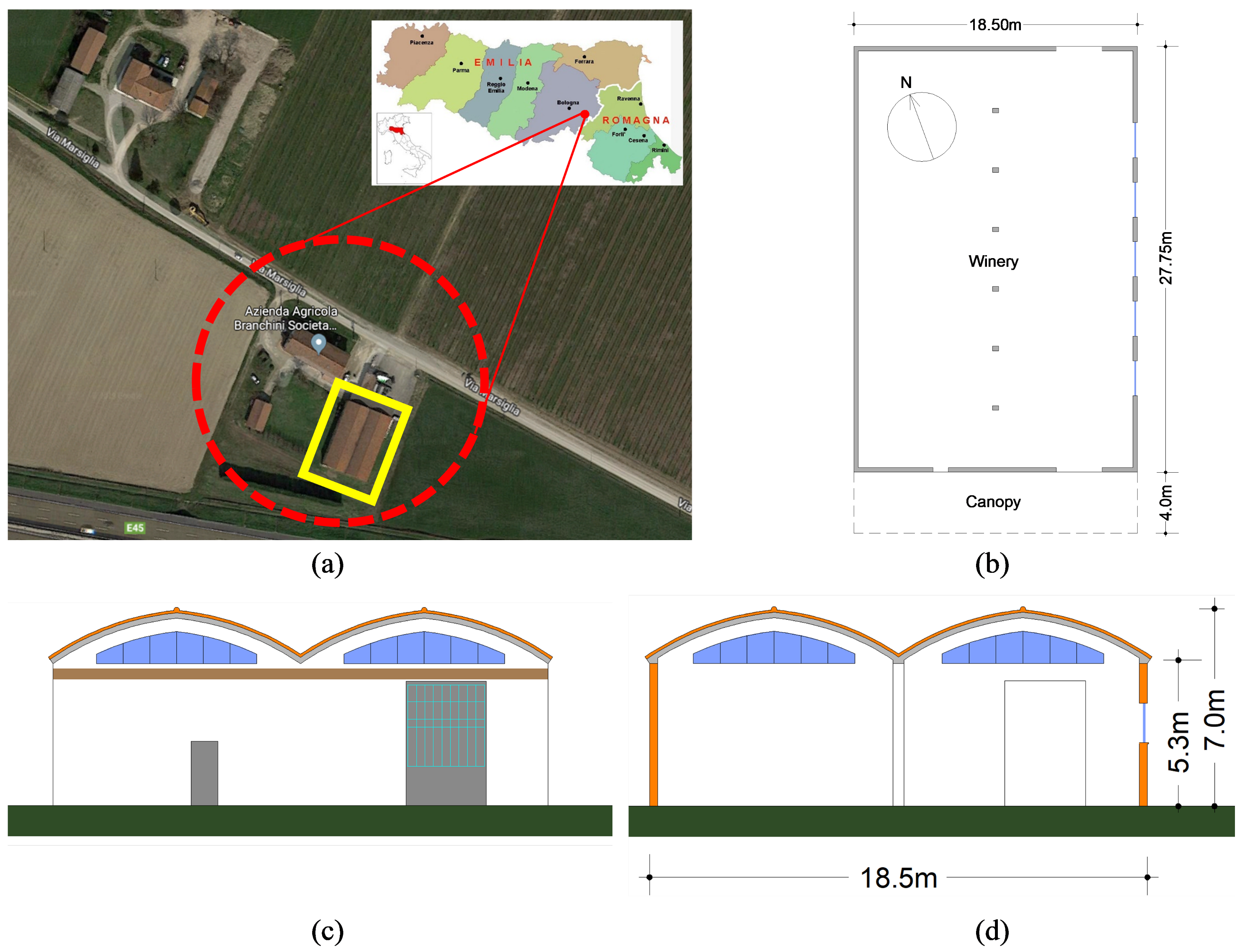

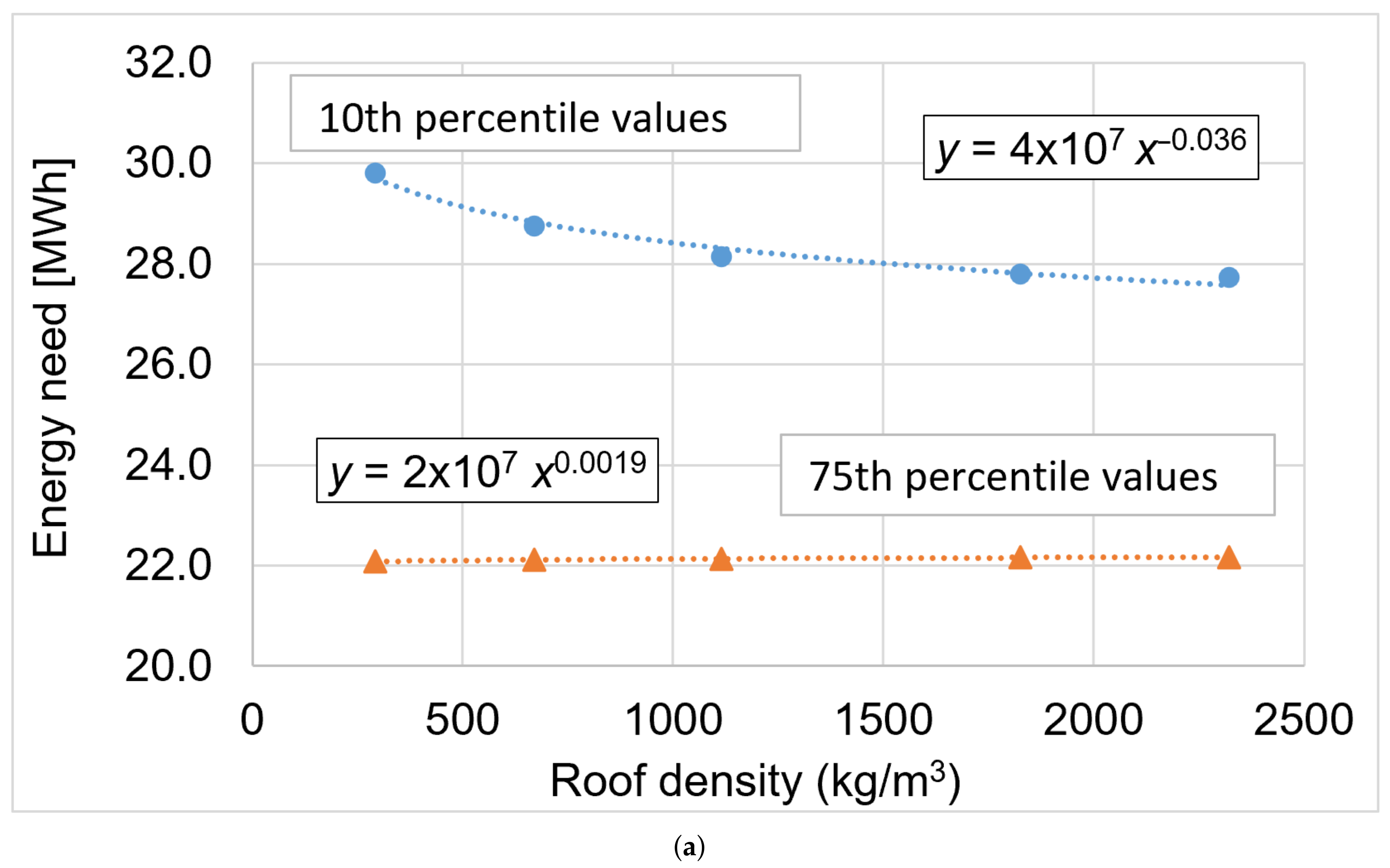
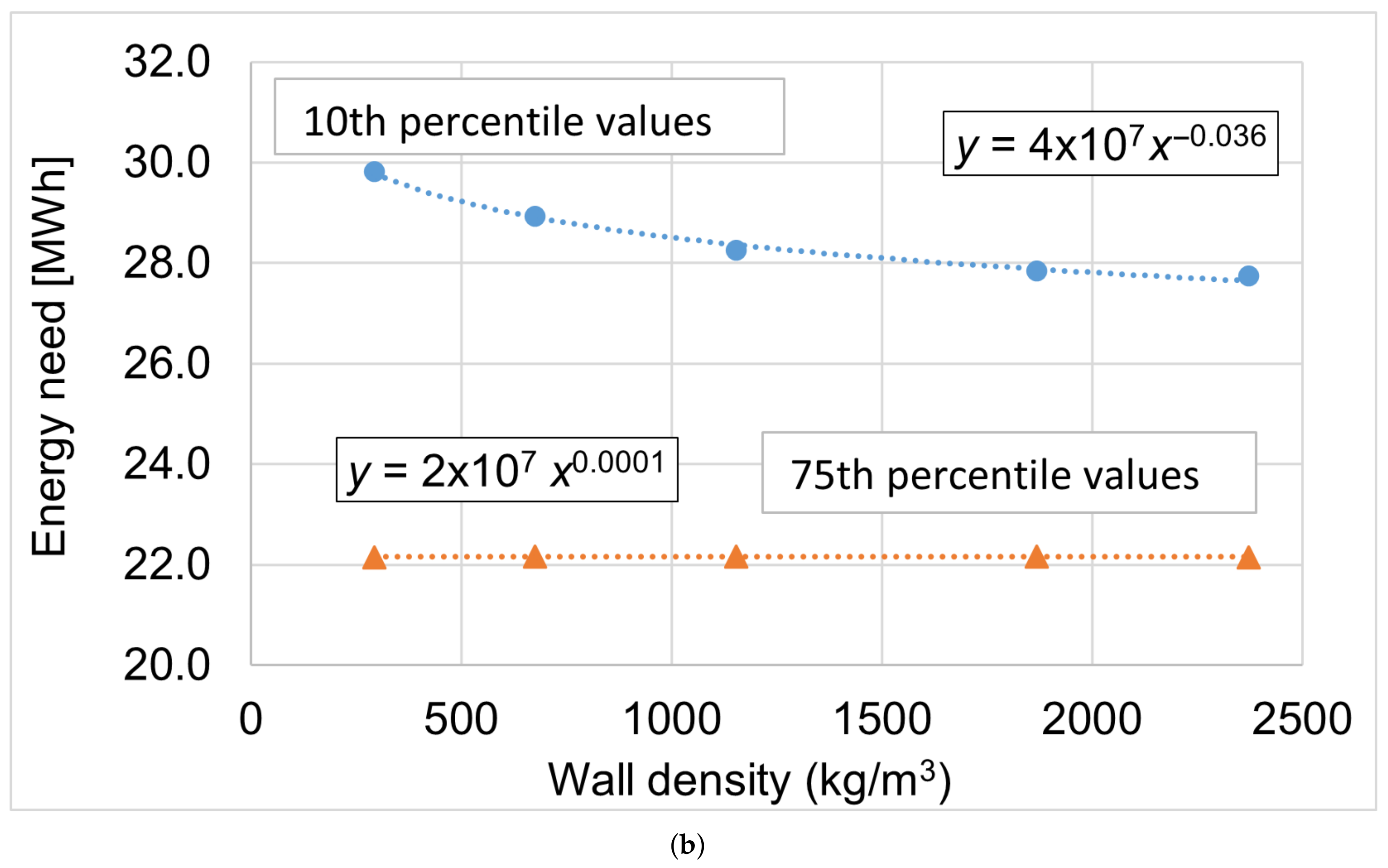
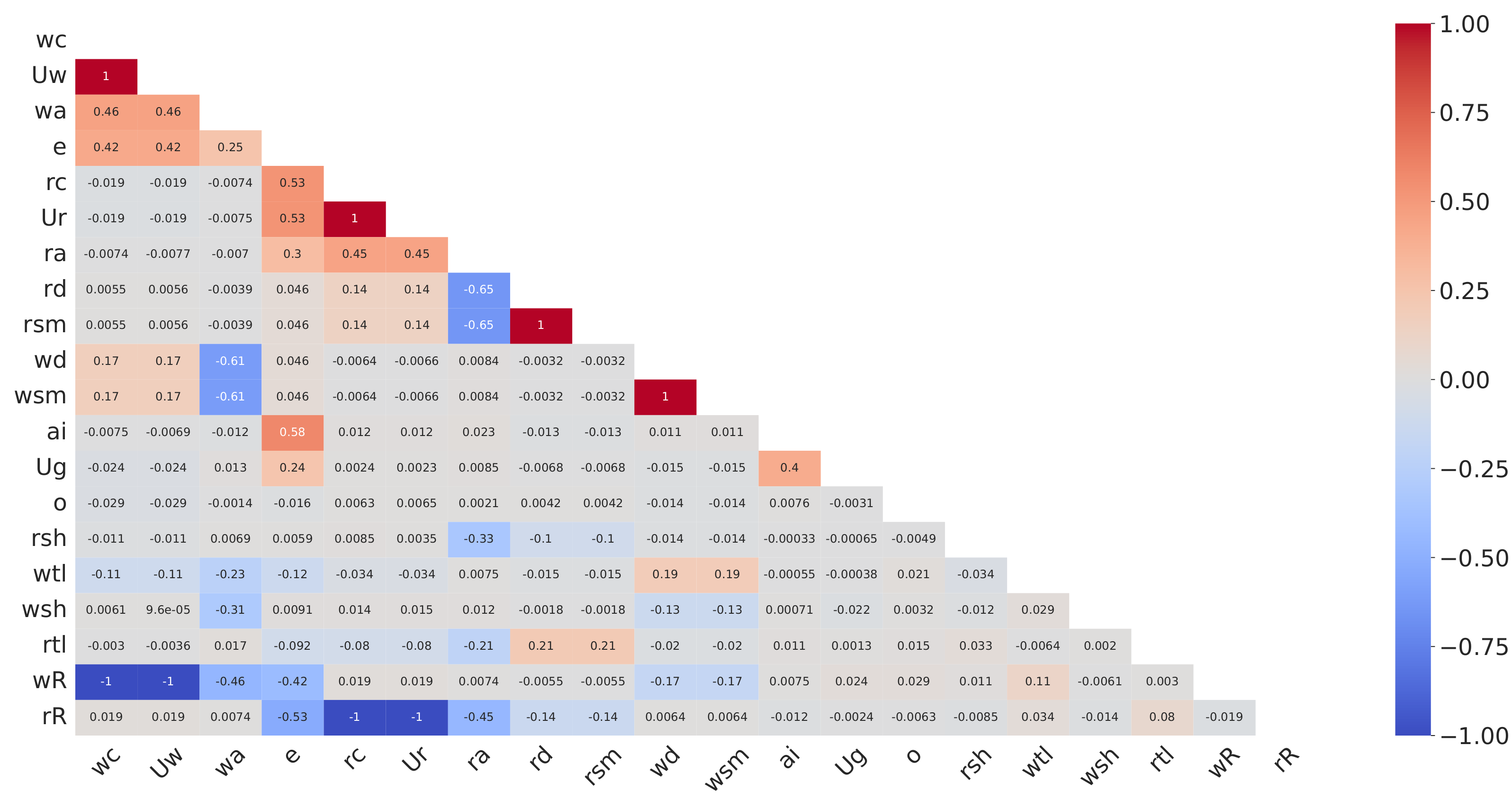

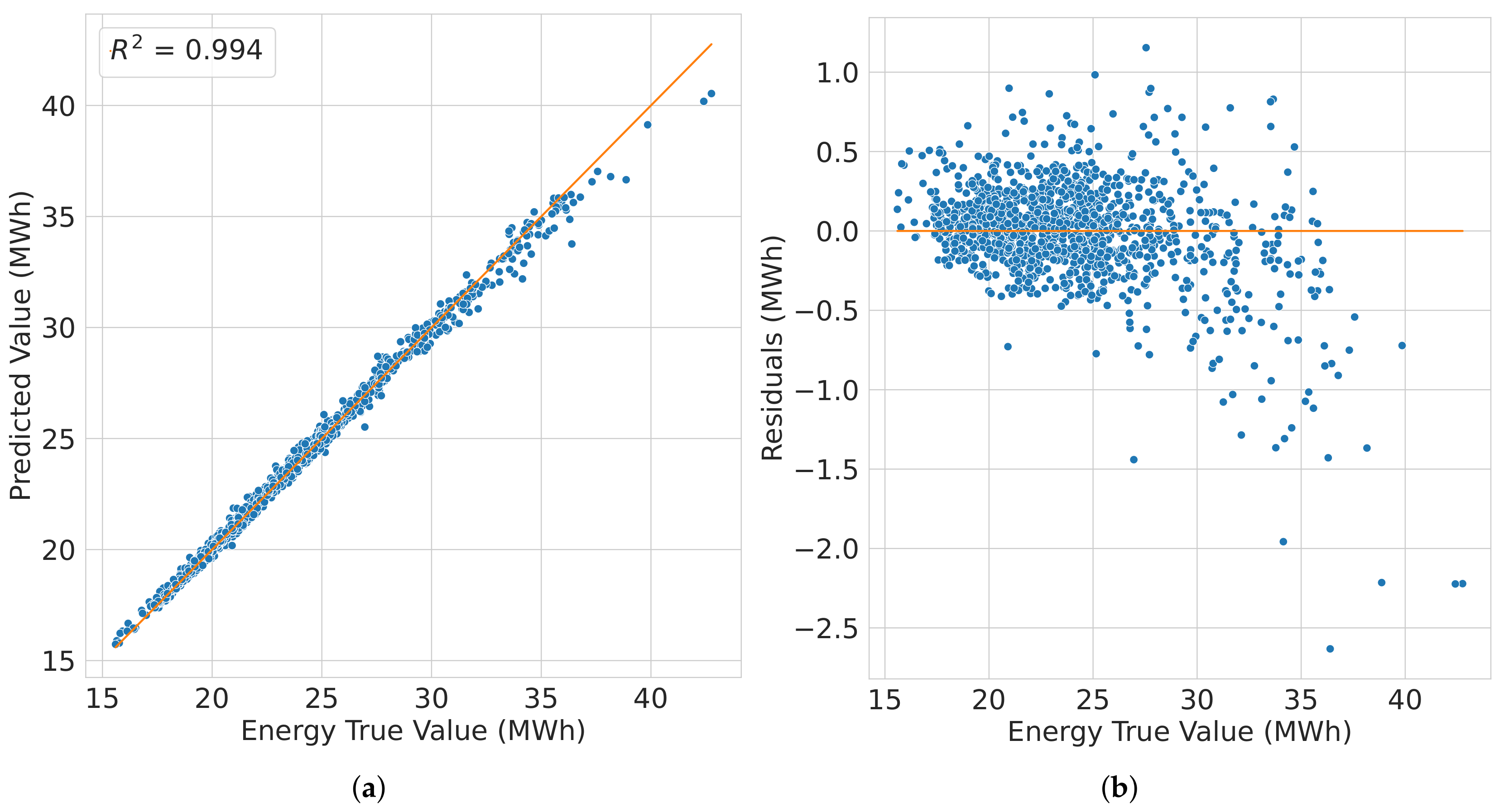
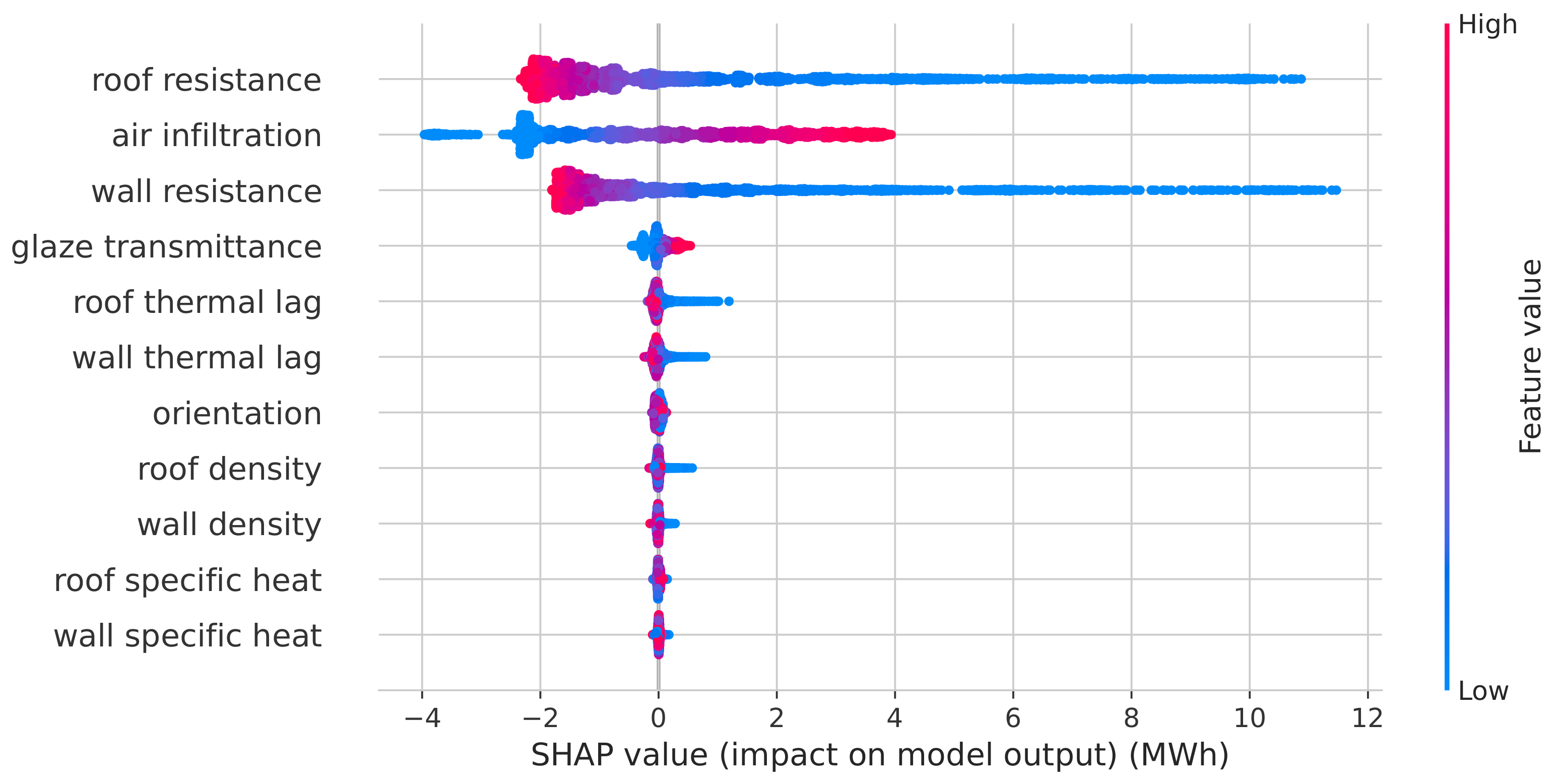
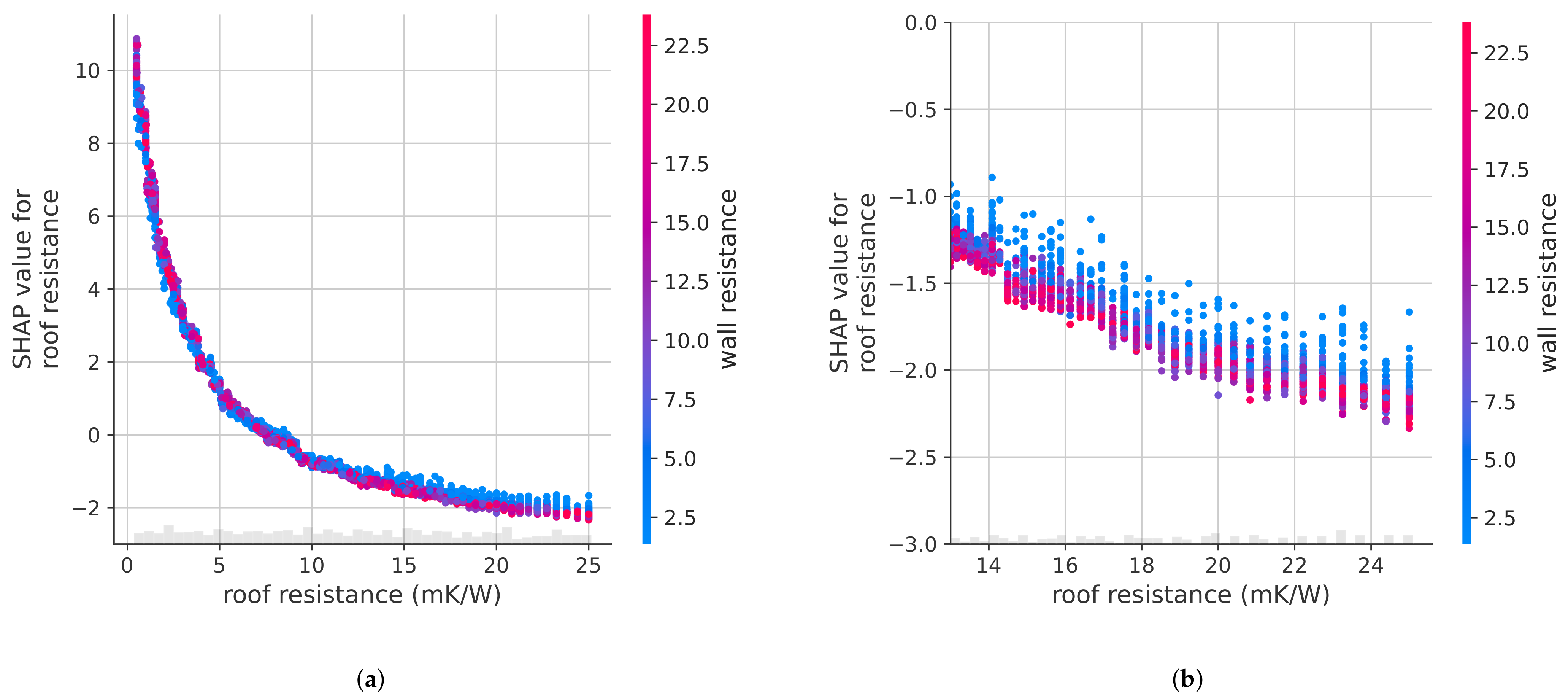
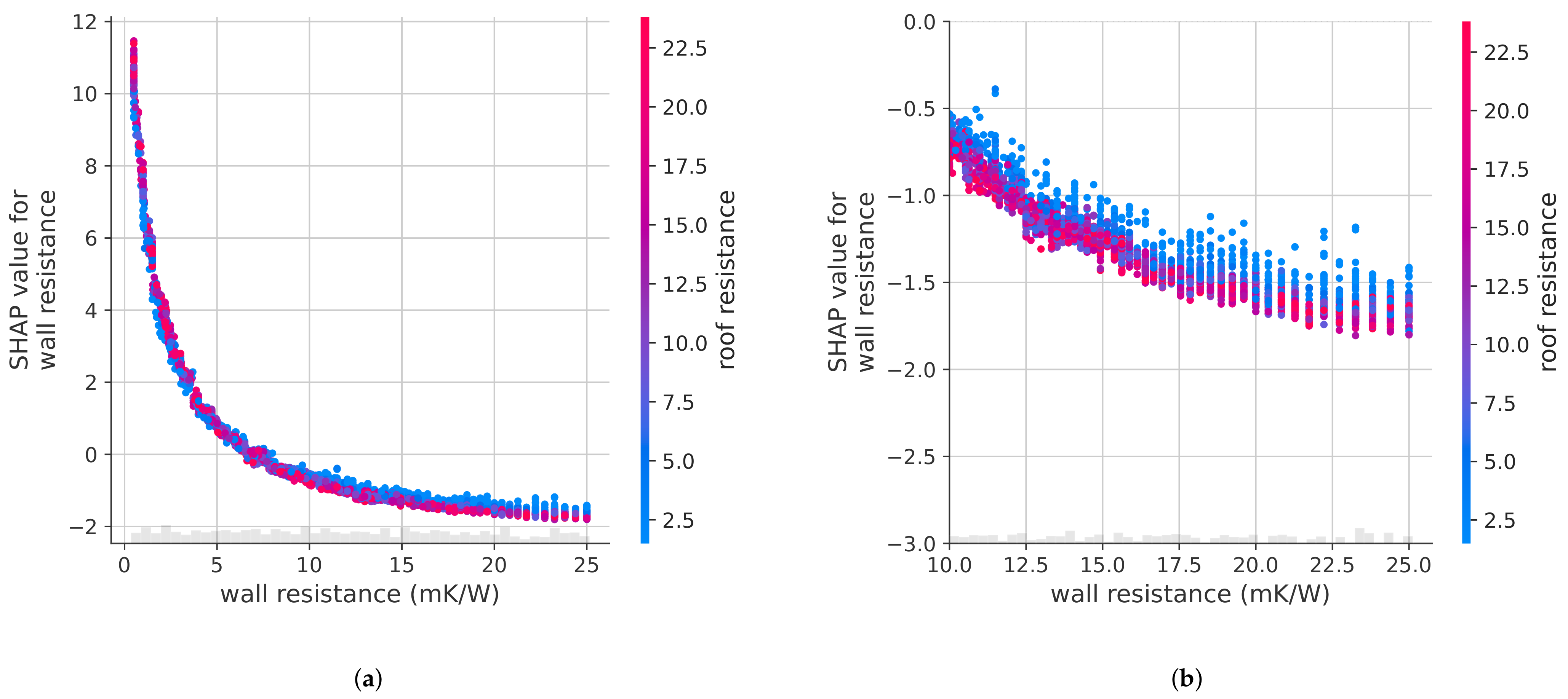
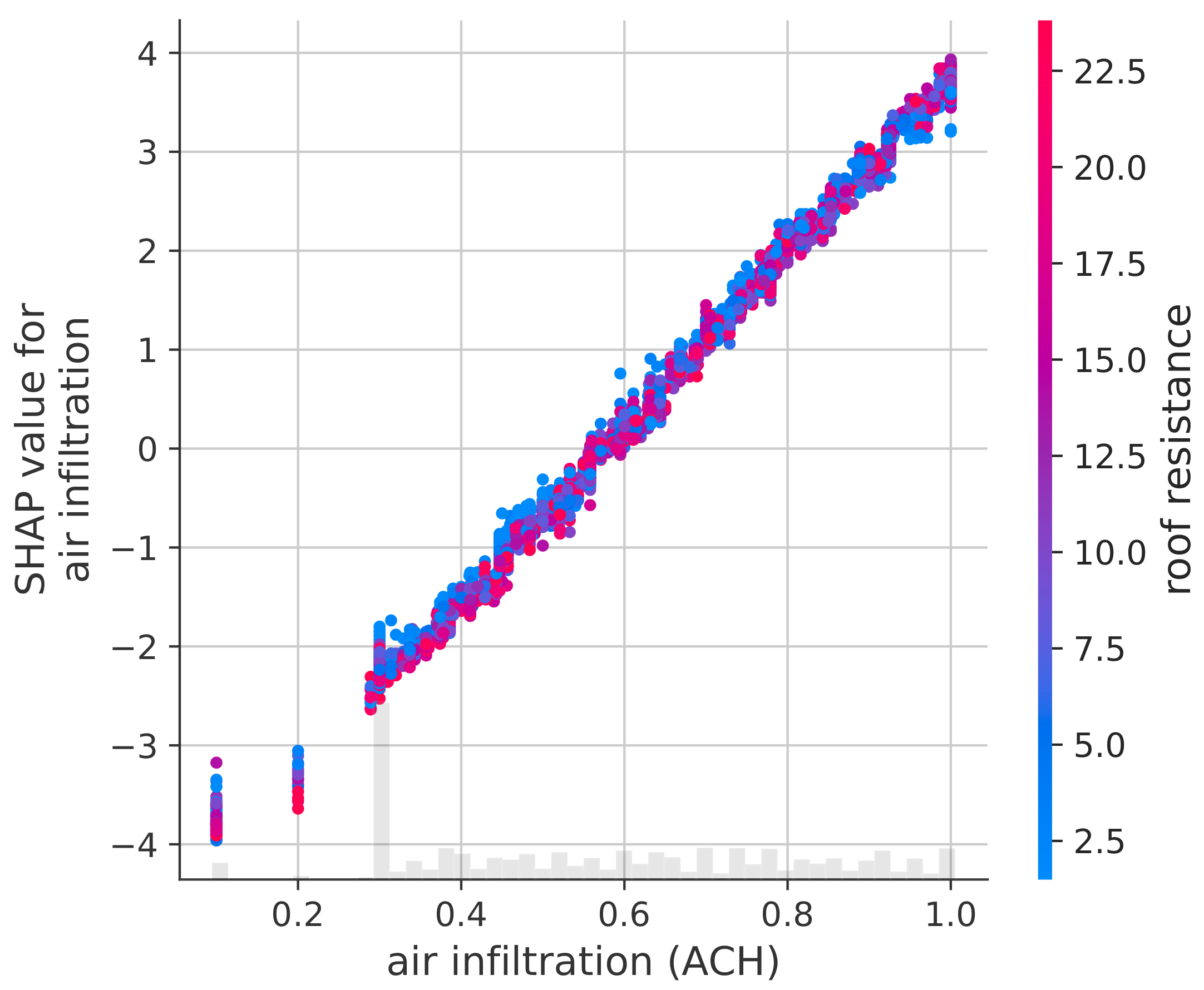
| Variable | Abbreviation | User/Software | Unit |
|---|---|---|---|
| wall resistance | wR | U | mK/W |
| wall conductivity | wc | U | W/mK |
| wall density | wd | U | kg/m |
| wall specific heat | wsh | U | J/(kgK) |
| wall transmittance | Uw | S | W/(mK) |
| wall superficial mass | wsm | S | kg/m |
| wall attenuation | wa | S | - |
| wall thermal lag | wtl | S | hours |
| roof resistance | rR | U | mK/W |
| roof conductivity | wc | U | W/mK |
| roof density | rd | U | kg/m |
| roof specific heat | rsh | U | J/(kgK) |
| roof transmittance | Ur | S | W/(mK) |
| roof superficial mass | rsm | S | kg/m |
| roof attenuation | ra | S | - |
| roof thermal lag | rtl | S | hours |
| orientation | o | U | degree |
| air infiltration | ai | U | ACH 1 |
| glaze transmittance | Ug | U | W/(mK) |
| Variable | Abbreviation | User/Software | Unit |
|---|---|---|---|
| wall resistance | wR | U | mK/W |
| wall density | wd | U | kg/m |
| wall specific heat | wsh | U | J/(kgK) |
| wall thermal lag | wtl | S | hours |
| roof resistance | rR | U | mK/W |
| roof density | rd | U | kg/m |
| roof specific heat | rsh | U | J/(kgK) |
| roof thermal lag | rtl | S | hours |
| orientation | o | U | degree |
| air infiltration | ai | U | ACH 1 |
| glaze transmittance | Ug | U | W/(mK) |
Publisher’s Note: MDPI stays neutral with regard to jurisdictional claims in published maps and institutional affiliations. |
© 2022 by the authors. Licensee MDPI, Basel, Switzerland. This article is an open access article distributed under the terms and conditions of the Creative Commons Attribution (CC BY) license (https://creativecommons.org/licenses/by/4.0/).
Share and Cite
Barbaresi, A.; Ceccarelli, M.; Menichetti, G.; Torreggiani, D.; Tassinari, P.; Bovo, M. Application of Machine Learning Models for Fast and Accurate Predictions of Building Energy Need. Energies 2022, 15, 1266. https://doi.org/10.3390/en15041266
Barbaresi A, Ceccarelli M, Menichetti G, Torreggiani D, Tassinari P, Bovo M. Application of Machine Learning Models for Fast and Accurate Predictions of Building Energy Need. Energies. 2022; 15(4):1266. https://doi.org/10.3390/en15041266
Chicago/Turabian StyleBarbaresi, Alberto, Mattia Ceccarelli, Giulia Menichetti, Daniele Torreggiani, Patrizia Tassinari, and Marco Bovo. 2022. "Application of Machine Learning Models for Fast and Accurate Predictions of Building Energy Need" Energies 15, no. 4: 1266. https://doi.org/10.3390/en15041266
APA StyleBarbaresi, A., Ceccarelli, M., Menichetti, G., Torreggiani, D., Tassinari, P., & Bovo, M. (2022). Application of Machine Learning Models for Fast and Accurate Predictions of Building Energy Need. Energies, 15(4), 1266. https://doi.org/10.3390/en15041266








